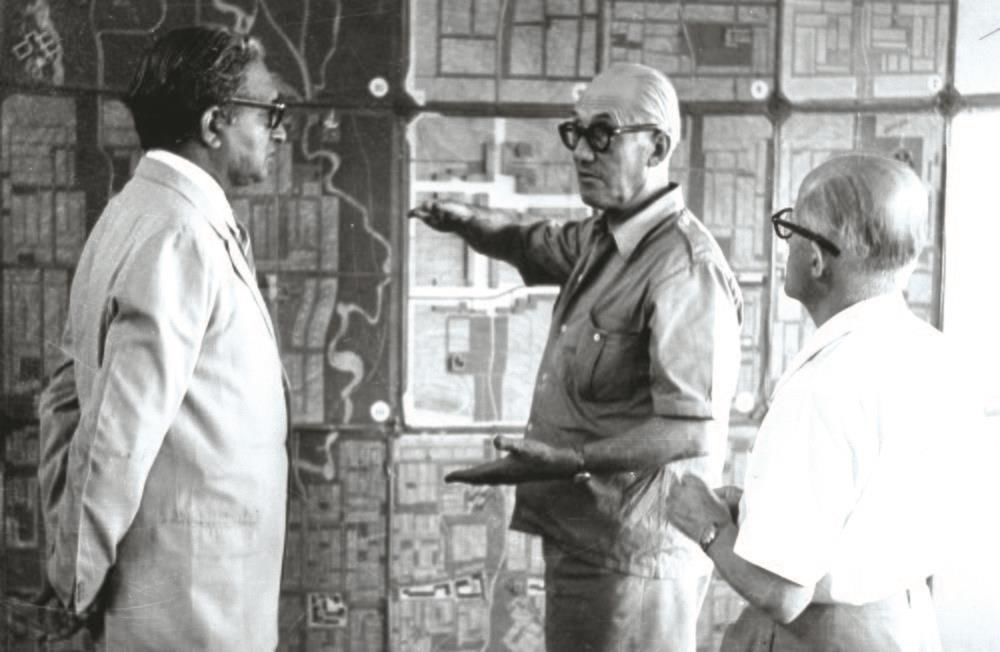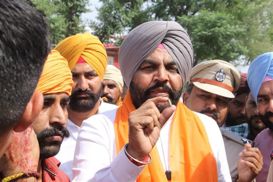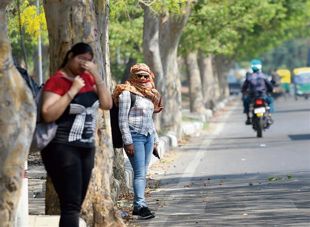
Le Corbusier (C) insisted that French engineers be hired for the project, but PL Varma (L) assured him that Indian engineers would do the job.
Rajnish Wattas & Deepika Gandhi
“Happiness, the aim of human existence on this earth, can be won by truth, self-discipline, integral knowledge, and a life of purity...”
Written for Le Corbusier, these words by Parmeshwari Lal Varma, the iconic Chief Engineer of Chandigarh, perhaps best describe his own life and work too. Varma had the longest and deepest connection with the Chandigarh project — right from its conception to realisation. He remained its lodestar, navigating the project’s ambitious if audacious leap into the future. He was the key engineer collaborator of the city’s legendary Swiss-French architect and planner Corbusier. He shared Corbusier’s sense of history in creating one of 20th century’s greatest experiments in urban planning.

Born on May 21, 1901, Varma graduated from the then elite Thompson Engineering College, Roorkee (now IIT-Roorkee) in 1924. He soon rose to be the Chief Engineer, PWD (Buildings & Roads), of joint Punjab at a young age. He successfully oversaw the construction of an Assembly building in Lahore in record time with very high quality of workmanship, for which he was honoured by the British government. He was also associated with the master plan for Lahore.

No wonder then that after Partition, when the team for the Chandigarh Capital Project was put together, the Punjab government picked him up. He was asked to formulate a project report along with AL Fletcher, a distinguished bureaucrat of the Indian Civil Service.
While Varma favoured building a large, independent city for five lakh people, most bureaucrats and politicians were keen on a small, purely administrative city, given the financial stringency and scepticism about a new ‘greenfield’ city flourishing.

In order to get his concept accepted, Varma lobbied intensively with the powers that be, including Prime Minister Jawaharlal Nehru, to whom he had access. After scrutinising a number of sites, the site selection committee headed by Varma chose the existing site of Chandigarh in Ambala district, as it met most of the requirements for the new city and got government approval.
Showing great foresight, Varma immediately started collecting material for the construction and developing plant nurseries — lest the government changed its mind again — even before the architect was finalised.
Initially, on the recommendation of Nehru, American planner Albert Mayer, who was already working in India on various town planning projects, was given the assignment. He, along with his close associate Mathew Nowicki, a brilliant young Polish-American architect, set up office in Shimla. Nowicki, after putting in weeks of diligent hard work to develop an initial architectural expression for the new town, left for America for a short break, promising to return soon and resume work along with Mayer. Varma, who went to Delhi to see him off, had a poignant memory of the farewell.
“Mathew Nowicki, while boarding the flight, came back from the customs line, even as his plane was on the tarmac, to especially say goodbye to Varma and convey that he had enjoyed working with him. In a spontaneous gesture, Nowicki gave him his sunglasses as a parting gift, which were very precious to Varma,” recall his grandchildren Udayan Sahgal and Madhavi Sahgal. And little did anyone know that it would be the last journey of the brilliant young architect, as the TWA flight he boarded crashed near Cairo.
Thus, substitute architect-planners for Mayer and Nowicki had to be found. Varma and PN Thapar, the Administrator of the Capital Project, were assigned the task of visiting European countries to interview architects and planners shortlisted by the Indian embassies. They left India on November 5, 1950, to return on December 24 after selecting Le Corbusier, his associate Pierre Jeanneret and the English architects Maxwell Fry and his wife Jane Drew.
Fry and Drew had strongly recommended Corbusier as the best person to lead such a visionary project. But when they met him in Paris, he was not very keen to take up the assignment. Varma appealed to the architect-planner and artist to accept the project, saying, “I am giving you the opportunity to design a whole city as an architect and a very white canvas to fill in with colours of your own choice as a painter. You have no option but to accept this offer.”
Corbusier insisted that French structural engineers, too, be hired for the project. But Varma assured him that they would manage it in-house with Indian engineers.
Mahendra Raj, a brilliant young engineer working in Varma’s team, recalled some of the challenges they had to negotiate while working on Corbusier’s Capitol Complex, with its unusual sculptural building designs. “The Secretariat building facade posed a big challenge as the design proposed by Corbusier defied structural stability. When Corbusier was told about the difficulty, he was furious and mocked Varma that his Indian engineering team could not deliver!”
Encouraged by Varma, Mahendra Raj showed Corbusier a slightly modified alternative that could work. Next day, Corbusier complimented the young engineer for his ingenuity and brilliance. The facade was modified by Corbusier accordingly and stands today as a testament to Varma’s trust in his Indian engineers.
BB Vohra, a young IAS officer of the first batch (1948) of the service, too, contributed to the city’s development significantly. He was first associated with it as the Deputy Secretary to the ‘Secretary, Capital Project’, beginning 1952, when the project had just got underway, till the early 1960s when it started coming up visibly on the skyline. Vohra later took over as the Secretary. He was sent to Australia to study the development of Canberra — which too was a new capital city of that decade — from where he brought back ideas relevant to the Chandigarh project. He also contributed to the drafting of the Punjab New Capital Development Act of 1952, the key enabling legislation for the project. His active involvement in the Capital Project stretched to over a decade in various official administrative positions.
Another huge contribution of PL Varma to Chandigarh’s sublime beauty is Sukhna Lake. He suggested the construction of a dam on Sukhna choe, a seasonal rivulet flowing by the site, that would create a lake on the north-east corner of the city. The idea of the lake in Chandigarh was not part of Corbusier’s original master plan, but Varma prevailed upon him to incorporate it. However, the additional funds required for it were not forthcoming. There was scepticism that instead of adding an attractive feature, the lake would turn out to be a pond of muddy water with buffaloes wallowing in it, brewing mosquitoes. Varma emphasised that the lake was essential for an assured supply of water to the city.
Eventually, the dam was completed, but it took a few years before the lake filled up and Varma had to face extreme criticism for it. During rains, everyone would wistfully look up, hoping that the lake would fill up, which it did eventually.
Later, Corbusier conceded, “Thanks to Varma, a lake was formed, sufficiently large to create a spectacle of the mountains and the sky reflected in the water.”
Varma was also instrumental in bringing Panjab University, that was scattered in a number of cities after 1947, to Chandigarh. He offered a full sector at a very concessional rate and recommended that another sector south-west of the present Sector 14 be reserved for its future growth. He also assigned the talented architect BP Mathur from the Chandigarh project to work along with Jeanneret on the university project.
So immense was his contribution that Corbusier used to call Varma ‘the soul of Chandigarh’. In one of his diaries, he wrote, “...a capital is born... the one responsible for it is in fact Varma, the man without personal ambition, always smiling with his eyes set on high goals.”
Corbusier’s high regard for Varma can be gauged from Jeanneret’s jibe: “You roar like a lion in front of me and others, but in front of Varma, you become a little lamb. What has he done to you?”
Old-timers fondly recall Varma’s towering and patrician personality. Beneath this exterior was a very warm and kind heart. He inspired his officers to work hard with honesty, integrity and commitment and, to his credit, Chandigarh was realised within the limitations of time, technology and budget.
When one of us met him to write an article for a prestigious architectural journal bringing out a special commemorative issue in 1987 on Corbusier’s birth centenary, initially, he was diffident, but agreed finally. In a rare gesture, he wrote a very insightful piece titled ‘Corbusier’s Brave New World’, but refused to accept the honorarium.
When Varma retired from service in 1956, he was given a farewell by the lakeside. Playfully, he was tied to a tree symbolising Varma’s life-long bond with the city of Chandigarh and Sukhna. He continued to serve the country as a member of the Union Public Service Commission from 1957 to 1962. For rendering meritorious professional service, he was awarded the Padma Bhushan in 1971. In 1974, he was invited by the Tanzanian government to advise them on their new capital at Dadoma.
Parmeshwari Lal Varma passed away in Chandigarh on April 2, 1995, but will always be remembered for demonstrating to the world the expertise and grit of Indian engineers, who executed one of 20th century’s greatest experiments in urban planning.
As a tribute to the ‘master builder’ and his pioneering team of engineers, it would be befitting if the old ‘Chief Engineer’s Office’ adjacent to Le Corbusier Centre in Sector 19, at present in a dilapidated condition, is restored and turned into a ‘Chandigarh Engineering Museum’. It would be the city’s befitting gesture of gratitude to those who built it.
Join Whatsapp Channel of The Tribune for latest updates.



























